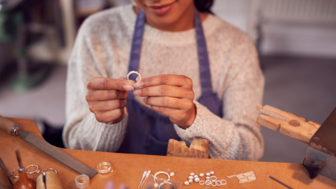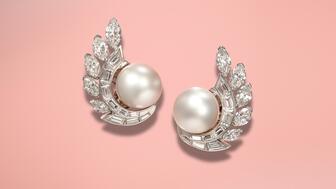The entrepreneur and “Shark Tank” star will share his top tips for success.
7 Questions on Diamond Marketing, Demand
Stephen Lussier of De Beers and the Diamond Producers Association on the thought process behind “Real is Rare,” why income inequality worries him and more.

Earlier this month at an event in Las Vegas, the Diamond Producers Association revealed the slogan that will be at the core of a new millennial- and U.S.-focused generic diamond advertising campaign: “Real is rare. Real is a diamond.”
The DPA developed the new slogan over the past several months, working alongside advertising agency Mother New York to survey a “representative sample” of Generation Y consumers in three U.S. cities: Boston, Chicago and Los Angeles. (The DPA is not releasing the exact number of millennials included in the research.)
After the shows, National Jeweler caught up with De Beers executive and DPA Chairman Stephen Lussier to talk more extensively about how the DPA arrived at “Real is Rare,” the U.S. presidential election, income inequality and how “A Diamond is Forever” fits in now.
National Jeweler: What about “Real is Rare. Real is a Diamond” do you think will connect with millennials?
Stephen Lussier: I think the two biggest insights from our research is one, this concept of what are relationships in this new era of a huge number of contacts?
This is a generation who, every day, have more interactions with more people than the generation before them would have even dreamed about. While they have a huge volume of contacts, they still sort of recognize that, ‘well, that’s not really enough.’ That, unlike [past] generations, they haven’t had the same depth of relationships. It’s a human need and they’re longing for it.
Part of the real core insight is, how do you recognize that feeling that they have and make sure your product is positioned for it? If you can attach your product to their basic need, it’s a very powerful place to be.
I think the other powerful insight that came from our study is that there is this desire for the authentic. It’s a word that they often used in the research. They used that language across lots of different categories [and] in the context of relationships. There’s a sort of this innate understanding amongst them that the diamond is the real deal. It’s one of those few products in life that stands the test of time and will be around forever.
The key is connecting those two things. If we can connect this innate feeling that they long for that relationship that is real and connect that with their desire to find some things in their world that are
NJ: When the DPA was conducting its research, were there a lot of questions from millennials about “blood” diamonds or general ethical questions about the product?
SL: Not as much as perhaps one would have expected. Interestingly, the main issue they have with diamonds is more perceptual … that they are a product that the previous generations used in a ritualistic way.
NJ: And millennials are not into rituals?
SL: They create their own rituals but they’re not into rituals that are seen to be things that are just there because society requires them. They find a different way of doing it.
Take marriage. It’s not that they are anti-marriage in any way. While they’re delaying it, they delay it because they want to have a very clear sense of themselves before they get married. They’ve got too much experience at watching marriages that haven’t succeeded, and they don’t want to follow that same path. So they’re more cautious and careful but still very keen on it.
When they understand and think about the role the diamond can play in terms of symbolizing that real emotion, it’s very powerful. If they think of the diamond simply as something you have get because that’s what you get when you get married, it’s not so powerful.
NJ: When you Google “diamonds,” many articles come up that wage the “diamonds aren’t rare” argument. Was there any hesitation about the word “rare” being used in the DPA’s campaign, any concerns it would set off a whole new wave of “no, diamonds aren’t rare” arguments?
SL: No, it wasn’t an issue in any of our consumer research. People inherently understand that diamonds are a precious natural product and because they are natural, they are limited.
Interestingly, the rare concept emanated less from focusing on the diamond than focusing on the concept of relationships, consumers recognizing that in their life, in a sea of endless superficial contacts, that real relationship, that was rare and that was special, and that was something that was precious and needed to be celebrated.
I am very happy to take that on (the rare argument) if it did come up. I don’t think it’s where the consumer is at all. I think that they intuitively appreciate that--that diamonds are rare. They recognize that there are rare ones and there are less rare ones, particularly when it comes to size and quality. But I don’t think it’s an issue with the consumers today.

NJ: Does the current state of the politics in the United States give you anxiety about how the year’s going to play out here in terms of diamond sales?
SL: What we look at carefully in America is the macro-economic environment. While it’s … not the steadiest of recoveries, the fundamentals for the diamond-buying consumer groups are pretty good. There’s every reason why America should be able to continue to perform reasonably well.
In the end, if the election campaign has a negative effect on the macro-economy, that’s not going to help. On the other hand, we have seen historically that election years aren’t bad for diamond purchasing.
The key is to watch the GDP growth and consumer spending, and so far it’s held up well through the first half of the year. And there’s no particular reason that it shouldn’t continue.
NJ: You mentioned fundamentals for the diamond-buying consumer groups are pretty good. Do you worry at all about income equality, about losing those middle-tier diamond buyers?
SL: I do, yeah. If you look back in terms of the economic crisis, those are the groups that the industry lost. We did lose significant numbers of unit sales at the lower end of the market as those population groups were much harder hit. And it think that’s not good for the universality of diamonds, which has always been at the heart of De Beers’ marketing--that there’s a diamond for every income, they’re all beautiful and everyone should have the opportunity to experience that joy.
So (income inequality) does concern us.
NJ: Is there anything else you’d like to add about the DPA campaign?
SL: Only that I think that some of the coverage I’ve read is sort of saying, “A Diamond is Forever is being replaced,” and I’ve never really thought of it that way. I think that the key for us, the De Beers Group, is to use those different tools effectively. (“A Diamond is Forever” is the intellectual property of the De Beers Group and De Beers uses it for its diamond brand, Forevermark, and De Beers Diamond Jewellers, its chain of retail stores.)
We find that the one-two combination is a knockout blow for the consumer. There’s still this power to the concept of timelessness. One of the things that makes diamonds special is they have this ability to transcend time and generation and relationships.
The benefit of now having the opportunity of a second tool (“Real is Rare”) is it empowers the DPA to go forward with this other really important aspects of diamonds--the authenticity. The combination of timeless and authenticity is pretty powerful.
This is not the end of one, the beginning of another. This is the addition of another powerful thought.
The Latest

The Ukrainian brand’s new pendant is modeled after a traditional paska, a pastry often baked for Easter in Eastern European cultures.

The jeweler has announced a grand reopening for its recently remodeled location in Peoria, Illinois.

The “Strong Like Mom” campaign features moms who work at Tiffany & Co. and their children.


Interior designer Athena Calderone looked to decor from the 1920s and 1930s when crafting her first fine jewelry collection.

During a call about its full-year results, CEO Efraim Grinberg discussed how the company is approaching the uncertainty surrounding tariffs.

Bench jewelers spend years honing their skills, Jewelers of America’s Certification validates their talents.

The free program provides educational content for jewelry salespeople and enthusiasts to learn or refresh their diamond knowledge.

The feedback will be used to prepare other jewelers for the challenges ahead, the organization said.

The online sessions are designed to teach jewelers to use AI tools like ChatGPT and Claude to grow their business.

The opening marks the jewelry retailer’s first location in the Midwest.

The “United in Love” collection offers tangible mementos of hearts entwined with traditional and non-traditional commitment heirlooms.

Robert Goodman Jewelers will hold a “Black Jewelry Designers and Makers” event on April 27.

The announcements follow a tumultuous start to 2025 for WJA, which saw a wave of resignations following controversial statements about DEI.

The historic fancy vivid blue diamond set to headline Christie’s Geneva sale next month could sell for up to $50 million.

LVMH CFO Cécile Cabanis also discussed the effects of tariffs so far.

The “Mad Men” and “The Morning Show” star steals jewelry, art, and handbags from his wealthy neighbors in “Your Friends & Neighbors.”

The organization has reelected Kalpesh Jhaveri as president.

An investigation found that the former managing director of Movado’s Dubai branch overstated and prematurely recorded sales.

The collection pays tribute to the Japanese philosophy of Ma, studying balance, stillness, and the interplay between presence and absence.

Mari Lou’s Fine Jewelry in Orland Park, a suburb of Chicago, is closing its doors.

GIA’s labs in Dubai and Hong Kong are now accepting larger diamonds in light of the “logistical challenges” presented by the new tariffs.

These earrings by Van Cleef & Arpels, featuring the same design as a pair worn by Princess Grace, are up for auction at Woolley & Wallis.

Two experts share how artificial intelligence tools can help retailers run a more efficient business.

Kentaro Nishimura, who has been with the pearl company since 1997, has been promoted to president and CEO of Mikimoto America.

“America Telling Time: 150 Years of Bulova” explores the storied history of the American watchmaker.




























